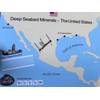Micro-Plastics in the Ocean a Problem?: Experts Meet in London
International experts have met in London to review the growing problems in the marine environment caused by micro-plastics – tiny pieces of plastic or fibres which may act as a pathway for persistent, bio-accumulating and toxic substances entering the food chain.
The experts form a key working group (WG-40) under the Joint Group of Experts on the Scientific Aspects of Marine Environmental Protection (GESAMP ), an advisory body that advises the United Nations (UN) system on the scientific aspects of marine environmental protection. The International Maritime Organization (IMO) is the Administrative Secretariat of GESAMP, which has, to date, produced more than 85 reports, including numerous in-depth technical studies contributing to the assessment on the state of the global marine environment.
The working group, which was meeting for its second session (from 23 to 25 July), completed a draft assessment report, covering the inputs of plastics and micro-plastics into the ocean, from land- and sea-based human activities; the mechanisms and rates of particle degradation and fragmentation; the processes controlling particle transport and accumulation; the interaction of micro-plastics with organisms, and potential physical and chemical impacts; and public perceptions about marine litter in general and micro-plastics in particular.
The workshop brought together experts in chemistry, ecology, eco-toxicology, human toxicology, materials science, physical oceanography, psychology, science-policy interface, social media and waste management, from nine countries on five continents, and observers from PlasticsEurope and the American Chemistry Council.
Plastic debris comes in a wide variety of sizes and compositions and has been found throughout the world’s oceans, carried by ocean currents and biological vectors, such as in the stomach contents of fish, mammals and birds. Plastics degrade extremely slowly in the open ocean, partly due to UV absorption by seawater and relatively low temperatures. The dumping of plastics into the sea from ships is prohibited under international treaties.
Micro-plastics are one of the degradation products of all plastics and may be small to very small, including just fibres or strands, with a range of compositions. They tend to fall into one of two categories: “primary” micro-plastic resin pellets used in the plastics industry, and in certain applications such as industrial abrasives and skin-care products; and “secondary” micro-plastics resulting from the degradation and breakdown of larger items, including so-called biodegradable plastics.
While micro-plastics may not pose an obvious risk to marine life – such as entanglement – due to the small size, nonetheless they may pose chemical or physical risks, especially on micro-fauna. Micro-plastics may also contribute to the transfer of pollutants from seawater to marine life.
Source: IMO














 February 2025
February 2025



